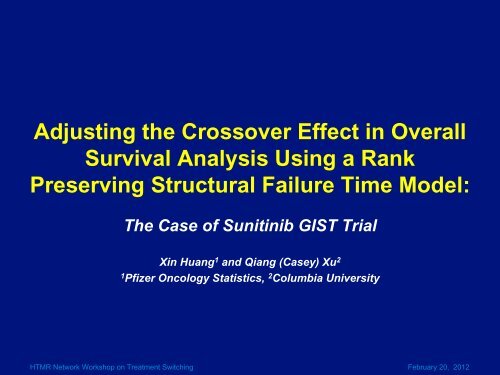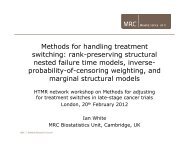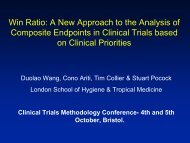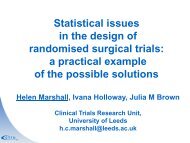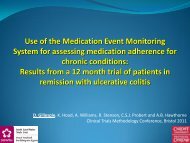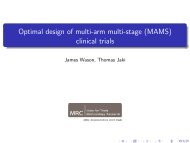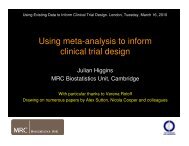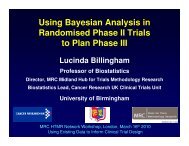Adjusting the Crossover Effect in Survival Analysis Using a Rank ...
Adjusting the Crossover Effect in Survival Analysis Using a Rank ...
Adjusting the Crossover Effect in Survival Analysis Using a Rank ...
You also want an ePaper? Increase the reach of your titles
YUMPU automatically turns print PDFs into web optimized ePapers that Google loves.
<strong>Adjust<strong>in</strong>g</strong> <strong>the</strong> <strong>Crossover</strong> <strong>Effect</strong> <strong>in</strong> Overall<strong>Survival</strong> <strong>Analysis</strong> Us<strong>in</strong>g a <strong>Rank</strong>Preserv<strong>in</strong>g Structural Failure Time Model:The Case of Sunit<strong>in</strong>ib GIST TrialX<strong>in</strong> Huang 1 and Qiang (Casey) Xu 21Pfizer Oncology Statistics, 2 Columbia UniversityHTMR Network Workshop on Treatment Switch<strong>in</strong>g February 20, 2012
Outl<strong>in</strong>e• Endpo<strong>in</strong>ts <strong>in</strong> Oncology Trials and Challenges• The Case of sunit<strong>in</strong>ib GIST Trial• <strong>Crossover</strong> Issues <strong>in</strong> Oncology Cl<strong>in</strong>ical Trials• Apply <strong>Rank</strong> Preserv<strong>in</strong>g Structural Failure Time(RPSFT) Model to sunit<strong>in</strong>ib GIST Case• ConclusionsHTMR Network Workshop on Treatment Switch<strong>in</strong>g February 20, 2012
Uniqueness of Oncology TrialsThe design and conduct of oncology trials are typicallymore complicated than trials for o<strong>the</strong>r diseases• Life threaten<strong>in</strong>g disease– Change of treatment upon disease progression• Non-randomized s<strong>in</strong>gle arm study• S<strong>in</strong>gle study• Active randomized controlled trial (RCT)• Multi-center, multi-national, co-operative group studyHTMR Network Workshop on Treatment Switch<strong>in</strong>g February 20, 2012
Types of Endpo<strong>in</strong>ts <strong>in</strong> Oncology• Solid tumors– Metastatic Disease:• Tumor response rate, Time to tumor progression, Progressionfree survival, Patient Reported Outcomes (PRO), Overall survival(OS)– Adjuvant Sett<strong>in</strong>g:• Time to recurrence, Disease free survival, PRO, OS• Hematological malignancies– Complete remission, Time to recurrence, Recurrence freesurvival, PRO, OSHTMR Network Workshop on Treatment Switch<strong>in</strong>g February 20, 2012
Overall <strong>Survival</strong> (OS)• OS is def<strong>in</strong>ed as <strong>the</strong> time from randomization until deathfrom any cause, and is measured <strong>in</strong> <strong>the</strong> <strong>in</strong>tent-to-treatpopulation• OS has long been <strong>the</strong> gold standard represent<strong>in</strong>g cl<strong>in</strong>icalbenefit <strong>in</strong> oncology• <strong>Survival</strong> is considered <strong>the</strong> most reliable cancer endpo<strong>in</strong>t,and when studies can be conducted to adequatelyassess survival, it is usually <strong>the</strong> preferred endpo<strong>in</strong>t• Bias is not a factor <strong>in</strong> endpo<strong>in</strong>t measurement• OS should be evaluated <strong>in</strong> randomized controlled studies(RCT)HTMR Network Workshop on Treatment Switch<strong>in</strong>g February 20, 2012
Objective Response Rate (ORR)• ORR is def<strong>in</strong>ed as <strong>the</strong> proportion of patients with tumorsize reduction of a predef<strong>in</strong>ed amount and for a m<strong>in</strong>imumtime period• Response duration usually is measured from <strong>the</strong> time of<strong>in</strong>itial response until documented tumor progression• Generally, ORR is def<strong>in</strong>ed as <strong>the</strong> sum of partialresponses (PR) plus complete responses (CR)• ORR is a direct measure of drug antitumor activity, whichcan be evaluated <strong>in</strong> a s<strong>in</strong>gle-arm study• Standardized criteria such as RECIST should be used toascerta<strong>in</strong> responseHTMR Network Workshop on Treatment Switch<strong>in</strong>g February 20, 2012
Time to Tumor Progression (TTP)• Time to Tumor Progression (TTP) is def<strong>in</strong>ed as <strong>the</strong> timefrom randomization until objective tumor progression• TTP has served as primary endpo<strong>in</strong>t for drug approval• TTP does not <strong>in</strong>clude deaths• In TTP analysis, deaths are censored, ei<strong>the</strong>r at <strong>the</strong> timeof death or at an earlier visit represent<strong>in</strong>g <strong>in</strong>formativecensor<strong>in</strong>g• The precise def<strong>in</strong>ition of tumor progression is importantand should be carefully detailed <strong>in</strong> <strong>the</strong> protocolHTMR Network Workshop on Treatment Switch<strong>in</strong>g February 20, 2012
Progression Free <strong>Survival</strong> (PFS)• PFS is def<strong>in</strong>ed as <strong>the</strong> time from <strong>the</strong> date of randomization to<strong>the</strong> date of <strong>the</strong> first documentation of progression or deathdue to any cause, whichever occurs first• Compared with TTP, PFS is <strong>the</strong> preferred regulatoryendpo<strong>in</strong>t• PFS <strong>in</strong>cludes deaths and thus can be a better correlate tooverall survival• PFS can reflect tumor growth and be assessed before <strong>the</strong>determ<strong>in</strong>ation of a survival benefit• Its determ<strong>in</strong>ation is not confounded by subsequent <strong>the</strong>rapy• However, <strong>the</strong> formal validation of PFS as a surrogate forsurvival for <strong>the</strong> many different malignancies can be difficultHTMR Network Workshop on Treatment Switch<strong>in</strong>g February 20, 2012
OS, TTP, and PFS Challenges• OS challenge – discont<strong>in</strong>uation/switch <strong>in</strong> <strong>the</strong>rapies (notrandomized) after adverse event/progression (crossover effect)– True treatment effect?• TTP and PFS Challenges – can progression be measuredreliably?– Difference <strong>in</strong> treatment regimen/schedule between treatment arms –open label– Difference <strong>in</strong> frequency/assessment times between treatment arms –biased estimates, false positive– Disagreement between INV and IRC– Change of <strong>the</strong>rapy after INV progression assessment– Scans not readable– Missed schedule– Measure some lesions - not all identified target lesions– Not all scans available for review by IRC (lagg<strong>in</strong>g btw. INV and IRC)HTMR Network Workshop on Treatment Switch<strong>in</strong>g February 20, 2012
Statistical Methods <strong>in</strong> Oncology• Kaplan-Meier estimator– an estimator for estimat<strong>in</strong>g <strong>the</strong>survival function from time-to-eventdata• Log-rank test– a hypo<strong>the</strong>sis test to compare <strong>the</strong>survival distributions of two samples• Cox proportional hazards model– if <strong>the</strong> proportional hazardsassumption holds <strong>the</strong>n it is possibleto estimate <strong>the</strong> effect parameter(s)without any consideration of <strong>the</strong>hazard functionDr. Paul Meier (1924-2011)Sir David CoxHTMR Network Workshop on Treatment Switch<strong>in</strong>g February 20, 2012
Sutent ® (sunit<strong>in</strong>ib malate)• Mechanism– Small molecule– Inhibits multiple receptortyros<strong>in</strong>e k<strong>in</strong>ases (RTKs)• Indication– Second-l<strong>in</strong>e <strong>in</strong>gastro<strong>in</strong>test<strong>in</strong>al stromaltumor (GIST)– First-l<strong>in</strong>e <strong>in</strong> renal cellcarc<strong>in</strong>oma (RCC)– First- or second-l<strong>in</strong>e <strong>in</strong>pancreatic neuroendocr<strong>in</strong>etumors (pNET)FNHH 3CNHC H 3ONHO.HO 2CNC H 3CH 3O HCO 2HHHTMR Network Workshop on Treatment Switch<strong>in</strong>g February 20, 2012
Phase 3 Trial of Sunit<strong>in</strong>ib<strong>in</strong> Imat<strong>in</strong>ib-resistant/-<strong>in</strong>tolerant GISTGIST - Gastro<strong>in</strong>test<strong>in</strong>al Stromal TumorImat<strong>in</strong>ib-resistant or-<strong>in</strong>tolerant GISTpatientsRandomization2:1(Sunit<strong>in</strong>ib:placebo)Sunit<strong>in</strong>ib (n=243)Sunit<strong>in</strong>ib50 mg/day, 4 weeks on, 2 weeks offPlacebo (n=118)Placebo4 weeks on, 2 weeks offCont<strong>in</strong>ue aslong as cl<strong>in</strong>icalbenefitCross over tosunit<strong>in</strong>ib atprogression<strong>Analysis</strong> <strong>in</strong>cludes patients who enrolled dur<strong>in</strong>g andsubsequent to <strong>in</strong>terim analysisHTMR Network Workshop on Treatment Switch<strong>in</strong>g February 20, 2012
Study Objectives• Primary– TTP (assessed by IRC accord<strong>in</strong>g to RECIST)• Sample size based on ability to detect a 50% <strong>in</strong>crease <strong>in</strong> medianTTP from 4 to 6 months• Secondary– OS, PFS, ORR– Patient-reported outcomes (pa<strong>in</strong> control, health state)– Safety monitor<strong>in</strong>g– Drug exposure and correlation with efficacy and safety– Biomarkers and correlative k<strong>in</strong>ase genotyp<strong>in</strong>gHTMR Network Workshop on Treatment Switch<strong>in</strong>g February 20, 2012
Results from <strong>the</strong> Primary Endpo<strong>in</strong>t• Patient accrual: December 2003 – May 2005• First planned <strong>in</strong>terim analysis for efficacy performed <strong>in</strong>January 2005• Primary endpo<strong>in</strong>t (TTP) statistically significant betweensunit<strong>in</strong>ib and placebo at <strong>in</strong>terim analysis• Treatment unbl<strong>in</strong>ded follow<strong>in</strong>g recommendation byIndependent Data Monitor<strong>in</strong>g Committee (IDMC) and allpatients randomized to placebo were offered sunit<strong>in</strong>ib.• Based on <strong>the</strong>se results, sunit<strong>in</strong>ib received approval from USFDA (Jan 2006) and EU (July 2006) for treatment of GISTafter disease progression on or <strong>in</strong>tolerance to imat<strong>in</strong>ib<strong>the</strong>rapyHTMR Network Workshop on Treatment Switch<strong>in</strong>g February 20, 2012
Time to Tumor Progression(Interim <strong>Analysis</strong> Based on IRC, 2005)Time to Tumor Progression Probability (%)1009080706050403020100Median, 95% CI6.3, (3.7, 7.6)1.5, (1.0, 2.3)Sunit<strong>in</strong>ib (n=178)Placebo (n=93)Hazard Ratio = 0.335p < 0.000010 3 6 9 12Time (Month)HTMR Network Workshop on Treatment Switch<strong>in</strong>g February 20, 2012
Overall <strong>Survival</strong> (NDA, 2005)Overall <strong>Survival</strong> Probability (%)100908070605040302010Sunit<strong>in</strong>ib (N=207)Placebo (N=105)Hazard Ratio=0.4995% CI (0.29, 0.83)p=0.007Total deaths29270nRisk SutentnRisk Placebo0 13 26 39 52 65 78 91 104Time (Week)207 13 / 114 9 / 61 4 / 25 3 / 2105 18 / 55 5 / 26 4 / 6 0 / NAHTMR Network Workshop on Treatment Switch<strong>in</strong>g February 20, 2012
Overall <strong>Survival</strong> (ASCO, 2006)Overall <strong>Survival</strong> Probability (%)100908070605040302010Sunit<strong>in</strong>ib (N=243)Placebo (N=118)Hazard Ratio=0.7695% CI (0.54, 1.06)p=0.107Total deaths89530nRisk SutentnRisk Placebo0 13 26 39 52 65 78 91 104Time (Week)243 17 / 214 16 / 187 22 / 142 19 / 86 7 / 47 5 / 23 2 / 5118 22 / 96 9 / 84 10 / 66 7 / 37 2 / 25 3 / 6 0 / NAHTMR Network Workshop on Treatment Switch<strong>in</strong>g February 20, 2012
Overall <strong>Survival</strong> (F<strong>in</strong>al, 2008)Overall <strong>Survival</strong> Probability (%)1009080706050403020100Total deaths17690Sunit<strong>in</strong>ib (N=243)Median 72.7 weeks95% CI (61.3, 83.0)Placebo (N=118)Median 64.9 weeks95% CI (45.7, 96.0)Hazard Ratio=0.87695% CI (0.679, 1.129)p=0.3060 26 52 78 104 130 156 182 208 234Time (Week)HTMR Network Workshop on Treatment Switch<strong>in</strong>g February 20, 2012
What We Know about Placebo Patients• 118 patients were randomized to placebo arm– 90 (76.3%) patients died• 103 (87.3%) patients crossed over from placebo to sunit<strong>in</strong>ibtreatment– 83 (70.3%) patients crossed over with<strong>in</strong> 3 months– 19 (16.1%) patients crossed over before disease progression– 4 (3.4%) patients never treated with placebo• 15 (12.7%) patients did not crossover– 12 patients diedHTMR Network Workshop on Treatment Switch<strong>in</strong>g February 20, 2012
Estimated Hazard Functions by Treatment0.025Sunit<strong>in</strong>ibPlacebo0.020Hazard Function0.0150.0100.0050.0000 13 26 39 52 65 78 91 104Time (Week)Hazard function is <strong>the</strong> <strong>in</strong>stantaneous failure rate at any po<strong>in</strong>t <strong>in</strong> timeHTMR Network Workshop on Treatment Switch<strong>in</strong>g February 20, 2012
Conventional AnalysesITT (naïve)Cox ModelHazard Ratio (SU/PB), 95% CIand p-value0.876 (0.679, 1.129), p=0.306ITT (dropp<strong>in</strong>gcrossover)ITT (censor<strong>in</strong>g atcrossover)ITT (time-dependenttreatment)0.315 (0.178, 0.555), p
<strong>Crossover</strong> Issues <strong>in</strong> Oncology Trials• Typical oncology trial designs compromiserandomization for <strong>the</strong> overall survival analysis– In placebo controlled randomized trials• Experimental (E) vs. Placebo (P): P → E– In active controlled randomized trials, if crossover is allowed• E + Standard of Care (S) vs. S: S → E + S• E vs. S: E → S and S → E– In active controlled randomized trials, if crossover is notallowed• E vs. S: E → NST and S → NST– A mix of crossover between study treatments and switch tonon-study treatments (NST)HTMR Network Workshop on Treatment Switch<strong>in</strong>g February 20, 2012
Impact of <strong>Crossover</strong> to OS <strong>Analysis</strong>• A comparison of arms for <strong>the</strong> treatment effect cannotbe made as randomized because of crossover• Whe<strong>the</strong>r <strong>the</strong> lack of efficacy results from a lack ofbenefit of <strong>the</strong> treatment, or <strong>the</strong> crossover hasobscured <strong>the</strong> benefit of treatment?• Conventional methods cannot fully adjust for <strong>the</strong>bias caused by crossover and cl<strong>in</strong>ical effect may beunderestimatedHTMR Network Workshop on Treatment Switch<strong>in</strong>g February 20, 2012
Not Have a Treatment <strong>Effect</strong> on OS• Higher hurdle to obta<strong>in</strong> <strong>the</strong> regulatory approval– Bevacizumab breast cancer <strong>in</strong>dication• Greater challenge to be accepted by <strong>the</strong> payers– The access and reimbursement environment is becom<strong>in</strong>gmore challeng<strong>in</strong>g as public and private payers scrut<strong>in</strong>ize <strong>the</strong>value and cost of pharmaceuticals more than ever.– Increas<strong>in</strong>gly, robust proof of cl<strong>in</strong>ical and/or economic valueis be<strong>in</strong>g required as a condition of coverage.– UK National Institute for Health and Cl<strong>in</strong>ical Excellence(NICE) cost effectiveness analysesHTMR Network Workshop on Treatment Switch<strong>in</strong>g February 20, 2012
Why/When Does <strong>Crossover</strong> Cause Bias?• Outcomes <strong>in</strong> <strong>the</strong> control arm reflect <strong>the</strong> benefit of <strong>the</strong>experimental drug• <strong>Crossover</strong> is a selective process– Not all of <strong>the</strong> patients who progress with <strong>the</strong> control drug crossover• The tim<strong>in</strong>g of crossover• For crossover to cause bias, <strong>the</strong> experimental treatment musthave some benefit for <strong>the</strong> endpo<strong>in</strong>t• If two treatments have <strong>the</strong> same effect, switch<strong>in</strong>g from one to<strong>the</strong> o<strong>the</strong>r shouldn’t affect <strong>the</strong> endpo<strong>in</strong>t• The <strong>in</strong>dication that crossover may cause bias can be identifiedby early signs of benefit– Earlier separation of survival curves, with gradual approach<strong>in</strong>gdue to <strong>in</strong>creas<strong>in</strong>g crossoverHTMR Network Workshop on Treatment Switch<strong>in</strong>g February 20, 2012
Standard Approaches to Analyze OS• ITT <strong>Analysis</strong>– Analyze patients as randomized and makes no adjustmentfor crossover• Per-protocol <strong>Analysis</strong>– Drop patients who cross over• On-Treatment <strong>Analysis</strong>– Censor patients when <strong>the</strong>y cross over• Time Dependent Treatment <strong>Analysis</strong> us<strong>in</strong>g <strong>the</strong> Cox modelThe later 3 approaches break <strong>the</strong> “exchangeability” created byrandomization. Outcomes are not representative of what wouldbe expected from <strong>the</strong> orig<strong>in</strong>ally randomized groupHTMR Network Workshop on Treatment Switch<strong>in</strong>g February 20, 2012
A Novel Solution to <strong>the</strong> <strong>Crossover</strong> Issue• Prefer <strong>in</strong>tent-to-treat (ITT) analysis and desire tocompare treatment groups as randomized• Estimate <strong>the</strong> unbiased treatment effect, as if nopatients <strong>in</strong> placebo arm had ever crossed over toexperimental arm.• <strong>Rank</strong> preserv<strong>in</strong>g structural failure time (RPSFT)model proposed by Rob<strong>in</strong>s and Tsiatis (1991) maybe used to remove bias <strong>in</strong>duced by crossoverHTMR Network Workshop on Treatment Switch<strong>in</strong>g February 20, 2012
Overall <strong>Survival</strong> (NDA, 2005)Overall <strong>Survival</strong> Probability (%)100908070605040302010Sunit<strong>in</strong>ib (N=207)Placebo (N=105)Hazard Ratio=0.4995% CI (0.29, 0.83)P=0.00700 26 52 78 104 130 156 182 208 234Time (Week)HTMR Network Workshop on Treatment Switch<strong>in</strong>g February 20, 2012
Overall <strong>Survival</strong> (F<strong>in</strong>al, 2008)Overall <strong>Survival</strong> Probability (%)100908070605040302010Sunit<strong>in</strong>ib (N=243)Median 72.7 weeks95% CI (61.3, 83.0)Placebo (N=118)Median 64.9 weeks95% CI (45.7, 96.0)Hazard Ratio=0.87695% CI (0.679, 1.129)p=0.30600 26 52 78 104 130 156 182 208 234Time (Week)HTMR Network Workshop on Treatment Switch<strong>in</strong>g February 20, 2012
Overall <strong>Survival</strong> (F<strong>in</strong>al, 2008)<strong>Crossover</strong> Adjusted by RPSFTOverall <strong>Survival</strong> Probability (%)100908070605040302010Sunit<strong>in</strong>ib (N=243)Median 72.7 weeks95% CI (61.3, 83.0)Placebo (N=118)Median* 39.0 weeks95% CI (28.0, 54.1)Hazard Ratio=0.50595% CI** (0.262, 1.134)p=0.30600 26 52 78 104 130 156 182 208 234Time (Week)*Estimated by RPSFT model**Empirical 95% CI obta<strong>in</strong>ed us<strong>in</strong>g bootstrap samples.HTMR Network Workshop on Treatment Switch<strong>in</strong>g February 20, 2012
Overall <strong>Survival</strong> (F<strong>in</strong>al, 2008)<strong>Crossover</strong> Adjusted by RPSFTOverall <strong>Survival</strong> Probability (%)1009080706050403020100Sunit<strong>in</strong>ib (N=207)Placebo (N=105)Sunit<strong>in</strong>ib (N=243)Median 72.7 weeks95% CI (61.3, 83.0)Placebo (N=118)Median* 39.0weeks95% CI (28.0, 54.1)Hazard Ratio=0.50595% CI** (0.262, 1.134)p=0.3060 26 52 78 104 130 156 182 208 234Time (Week)*Estimated by RPSFT model**Empirical 95% CI obta<strong>in</strong>ed us<strong>in</strong>g bootstrap samples.HTMR Network Workshop on Treatment Switch<strong>in</strong>g February 20, 2012
Overall <strong>Survival</strong> ResultsMedian OS (weeks; 95% CI)Sunit<strong>in</strong>ib Placebo HR (95% CI) P-valueInterim (bl<strong>in</strong>ded phase)based on ITTNot reached Not reached 0.491(0.290-0831)0.007F<strong>in</strong>al (bl<strong>in</strong>ded + openlabel)based on ITT72.7(61.3-83.0)64.9(45.7-96.0)0.876(0.679-1.129)0.306F<strong>in</strong>al (bl<strong>in</strong>ded + openlabel)based on ITT us<strong>in</strong>gRPSFT Method72.7(61.3-83.0)39.2(28.0-54.1)0.505(0.262-1.134)0.306HTMR Network Workshop on Treatment Switch<strong>in</strong>g February 20, 2012
The End of <strong>the</strong> Story• The f<strong>in</strong>al GIST OS result was <strong>in</strong>cluded <strong>in</strong> USPI (2009)– “…… N<strong>in</strong>ety-n<strong>in</strong>e of <strong>the</strong> patients <strong>in</strong>itially randomized toplacebo crossed over to receive SUTENT <strong>in</strong> <strong>the</strong> open-labeltreatment phase. At <strong>the</strong> protocol specified f<strong>in</strong>al analysis ofOS, <strong>the</strong> median OS was 72.7 weeks for <strong>the</strong> SUTENT armand 64.9 weeks for <strong>the</strong> placebo arm [HR= 0.876, 95% CI(0.679, 1.129)].”• NICE f<strong>in</strong>al appraisal determ<strong>in</strong>ation sunit<strong>in</strong>ib for <strong>the</strong>treatment of GIST (May, 2009)– “Sunit<strong>in</strong>ib is recommended as a treatment option for peoplewith unresectable and/or metastatic malignantgastro<strong>in</strong>test<strong>in</strong>al stromal tumours ……”HTMR Network Workshop on Treatment Switch<strong>in</strong>g February 20, 2012
O<strong>the</strong>r Applications of RPSFT <strong>in</strong> Cost<strong>Effect</strong>iveness AnalysesTherapy and Tumor TypeSunit<strong>in</strong>ib for <strong>the</strong> second-l<strong>in</strong>e treatment of GIST (2009)Pazopanib for <strong>the</strong> first-l<strong>in</strong>e treatment of RCC (2010)Everolimus for <strong>the</strong> second-l<strong>in</strong>e treatment of RCC (2010)Trastuzumab + anastrozole for postmenopausal womenwith HER2+ and HR+ BC (2010)Letrozole and anastrozole vs. tamoxifen as adjuvant<strong>the</strong>rapy <strong>in</strong> postmenopausal women with early BC (2011)MethodRPSFTRPSFTIPCW*RPSFTIPCWRPSFTRPSFTIPCW*IPCW – Inverse probability of censor<strong>in</strong>g weight<strong>in</strong>g methodsHTMR Network Workshop on Treatment Switch<strong>in</strong>g February 20, 2012
Conclusions• The benefit demonstrated <strong>in</strong> TTP <strong>in</strong> sunit<strong>in</strong>ib GIST trial islikely to translate <strong>in</strong>to an OS benefit <strong>in</strong> Imat<strong>in</strong>ib-resistantor <strong>in</strong>tolerant GIST patients• <strong>Crossover</strong> is a common and unavoidable issue <strong>in</strong>oncology cl<strong>in</strong>ical trials and its impact should be properlyaddressed• RPSFT model conceptually can address <strong>the</strong> problem ifassumptions are considered to be reasonable• RPSFT model provides a randomization-based estimateof treatment effect corrected for <strong>the</strong> bias caused bycrossover• RPSFT model can be used to perform a sensitivityanalysis to support <strong>the</strong> ITT analysisHTMR Network Workshop on Treatment Switch<strong>in</strong>g February 20, 2012
References• Rob<strong>in</strong>s JM, and Tsiatis AA. Correct<strong>in</strong>g for non-compliance <strong>in</strong> randomizedtrials us<strong>in</strong>g rank preserv<strong>in</strong>g structural failure time models. Communications<strong>in</strong> Statistics. - Theory and Methods 1991; 20(8): 2609-2631.• Rob<strong>in</strong>s J M, Mark SD, and Newey WK. Estimat<strong>in</strong>g exposure effect bymodel<strong>in</strong>g <strong>the</strong> expectation of exposure conditional on confounders.Biometrics 1992; 48: 279-495.• Mark SD, and Rob<strong>in</strong>s JM. Estimat<strong>in</strong>g <strong>the</strong> causal effect of smok<strong>in</strong>g cessation<strong>in</strong> <strong>the</strong> presence of confound<strong>in</strong>g factors us<strong>in</strong>g a rank preserv<strong>in</strong>g structuralfailure time model. Statistics <strong>in</strong> Medic<strong>in</strong>e 1993; 12: 1605-1628.• White IR, Babiker AG, Walker S, Darbyshire JH. Randomization-basedmethods for correct<strong>in</strong>g for treatment changes: examples from <strong>the</strong> Concordetrial. Statistics <strong>in</strong> Medic<strong>in</strong>e 1999; 18:2617-2634.• Guidance for Industry: Cl<strong>in</strong>ical Trial Endpo<strong>in</strong>ts for <strong>the</strong> Approval of CancerDrugs and Biologics. 2007HTMR Network Workshop on Treatment Switch<strong>in</strong>g February 20, 2012


